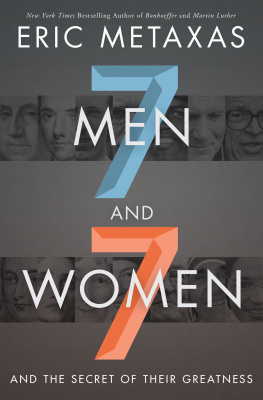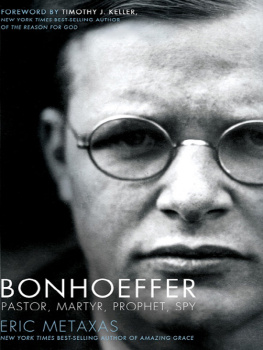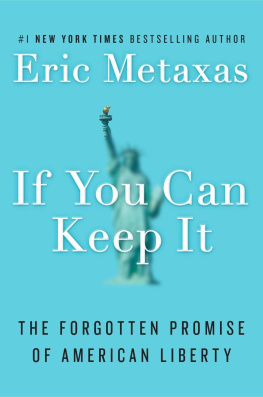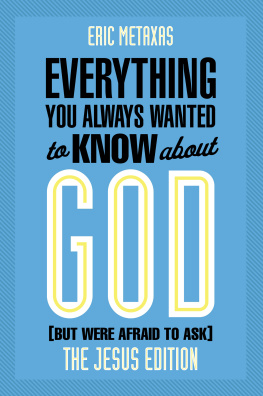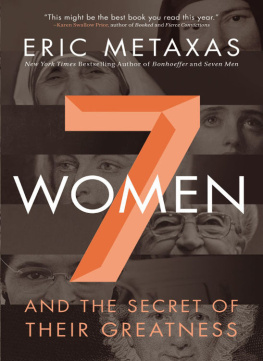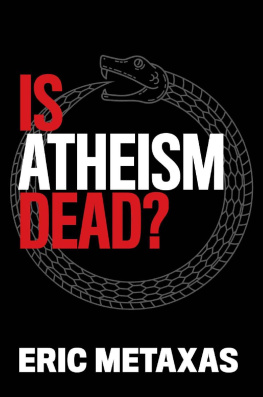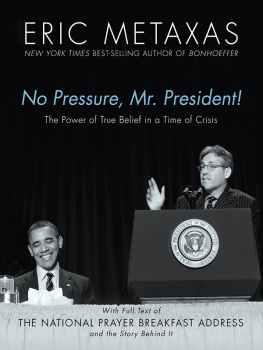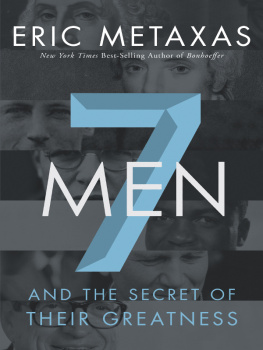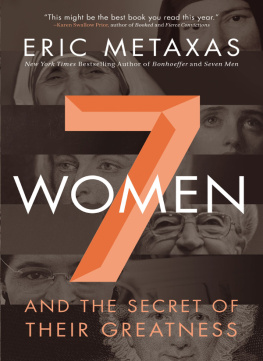Publishers note: Highly offensive racial slurs occur in of Seven Men. As this language is an integral part of Jackie Robinsons story, the publisher has decided to let the language stand, contrary to our general policy. If the reader finds the language uncomfortable, that is as it should be.
Seven Men 2013, 2016 by Eric Metaxas
Seven Women 2015, 2016 by Eric Metaxas
All rights reserved. No portion of this book may be reproduced, stored in a retrieval system, or transmitted in any form or by any meanselectronic, mechanical, photocopy, recording, scanning, or otherexcept for brief quotations in critical reviews or articles, without the prior written permission of the publisher.
Published in Nashville, Tennessee, by Nelson Books, an imprint of Thomas Nelson. Nelson Books and Thomas Nelson are registered trademarks of HarperCollins Christian Publishing, Inc.
Thomas Nelson titles may be purchased in bulk for educational, business, fund-raising, or sales promotional use. For information, please email SpecialMarkets@ThomasNelson.com.
Scripture quotations in Seven Women are from the New King James Version. Copyright 1982 by Thomas Nelson. Used by permission. All rights reserved.
Scripture quotations marked KJV are from the King James Version.
Scripture quotations marked NIV are from the Holy Bible, New International Version, NIV. Copyright 1973, 1978, 1984 by Biblica, Inc. Used by permission of Zondervan. All rights reserved worldwide. www.zondervan.com.
Scripture quotations marked PHILLIPS are from J. B. Phillips: The New Testament in Modern English, Revised Edition. J. B. Phillips 1958, 1960, 1972. Used by permission of Macmillan Publishing Co., Inc.
Scripture quotations marked NASB are from the New American Standard Bible, The Lockman Foundation 1960, 1962, 1963, 1968, 1971, 1972, 1973, 1975, 1977, 1995. Used by permission.
Chapter opening photo credits in Seven Men: Wilberforce and Washington, Library of Congress; Liddell and Robinson, Alamy; Bonhoeffer, Art Resource; Colson, Colson Center; Pope John Paul II, Getty Images
Chapter opening photo credits in Seven Women: Maria Skobtsova: Art Resource Photo; Hannah More: Art Resource Photo; Corrie ten Boom: Corrie ten Boom House Foundation; Susanna Wesley: Granger Images; Mother Teresa: Art Resource Photo; Joan of Arc: Bridgeman Images; Rosa Parks: Public Domain
Epub Edition August 2018 9781400211098
ISBN: 978-0-7180-2183-2 (HC) | ISBN: 978-0-7180-3729-1 (IE) |
ISBN: 978-1-59555-469-7 (HC) | ISBN: 978-1-40027-605-9 (IE) |
ISBN: 978-0-7180-8891-0 (TP) |
Printed in the United States of America
18 19 20 21 22 LSC 6 5 4 3 2 1
Information about External Hyperlinks in this ebook
Please note that footnotes in this ebook may contain hyperlinks to external websites as part of bibliographic citations. These hyperlinks have not been activated by the publisher, who cannot verify the accuracy of these links beyond the date of publication.
CONTENTS
THIS BOOK IS DEDICATED
TO MY FATHER, NICHOLAS METAXAS.
M A
Contents
A s most people would concur, the idea of manhood has fallen into some confusion in the last decades. This book hopes to help correct some of that by asking and answering two vitally important questions: First, what is a man? And second, what makes a man great?
And youll forgive me if I begin with John Wayne. The Duke is obviously not one of the seven men in this book, but many men of my generation have thought of him as something of an icon of manhood and manliness. We still do. But why? What is it about him? Is it the toughness and the swagger? Is it just that he comes across as big and strong and that most men aspire to those qualities? Well, that all has something to do with it, but I actually think his iconic status is because he usually played roles in which his size and strength were used to protect the weak. He was the good guy. He was always strong and tough but never a bully. Somehow watching him on the silver screen said more to generations of men (and women) about what made a man great than endless discussions on the subject. Sometimes a living picture really is worth a thousand words. And what we think of John Wayne is a clue to the secret of the greatness of the men in this book.
So this is a book that doesnt talk about manhoodat least not after this introduction, which you may skip if you like, although youve already come this far, so why stop?but that shows it in the actual lives of great men. You can talk about right and wrong and good and bad all day long, but ultimately people need to see it. Seeing and studying the actual lives of people is simply the best way to communicate ideas about how to behave and how not to behave. We need heroes and role models.
Now, my own personal greatest role model is Jesus. And you may have noticed that he didnt just talk. Of course he said a lot of extraordinary things, but he also lived with his disciples for three years. They saw him eat and sleep and perform miracles. They saw him live life and suffer and die. They saw him interact with all kinds of people, including themselves. He lived among them. Thats the main way that he communicated himself to the men who would communicate him to the world. Thats how he made discipleswho would make disciples, who would make disciples. So from the gospel stories of Jesus life, you get the idea that seeing a persons life is at least as important as getting a list of lessons from that person. Yes, sermons are important, but seeing the actual life of the guy who gives the sermon might be even more powerful. And you get the idea that how you live affects others. It teaches them how to live.
Historically speaking, role models have always been important. Until recently. The ancient Greeks had Plutarchs Lives, and in the sixteenth century we got Foxes Book of Martyrs. The message in these and similar books was that these lives were great and worthy of emulation. Having role models and heroes was historically a vital way of helping a new generation know what it should be aiming at. This is one of the main reasons I wrote biographies of William Wilberforce (Amazing Grace: William Wilberforce and the Heroic Campaign to End Slavery) and Dietrich Bonhoeffer (Bonhoeffer: Pastor, Martyr, Prophet, Spy). By the way, one of the last books that Bonhoeffer himself was reading just before he died was Plutarchs Lives.
So the idea of having heroes and role models has historically been very important; but as I say, somehow this has changed in recent years. What happened?
QUESTION AUTHORITY
Part of what happened is thatsince roughly the late 1960sweve adopted the idea that no one is really in a position to say whats right or wrong. So were loath to point to anyone as a good role model. Who am I to judge anyone? has almost become the mantra of our age.
But how did that happen? Well, its complicated. But it probably has something to do with the Vietnam War and with Watergate. Without a doubt these events helped accelerate a trend toward suspicion of the official version of things and of our leaders. Until Vietnam, all previous wars were generally seen as worthy of fighting, and the overwhelming cultural message was that patriotic Americans must do their duty and pitch in and help defend our country and our freedoms. With Vietnam, all that changed. Ditto with Watergate: for the first time in historythanks mainly to the taped conversations in the White Housewe saw and heard a US president not acting presidential at all but acting ignobly and venally and shamefully. We heard him use words we wouldnt want our children to use.

